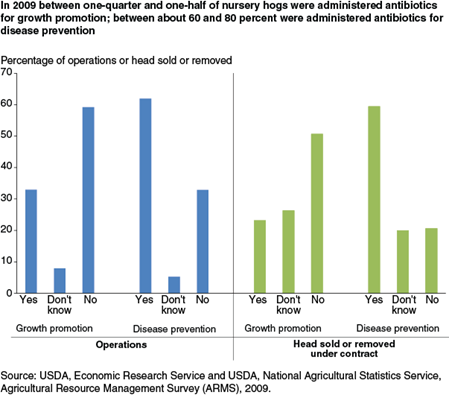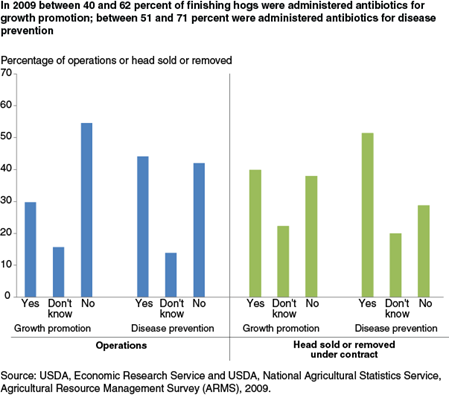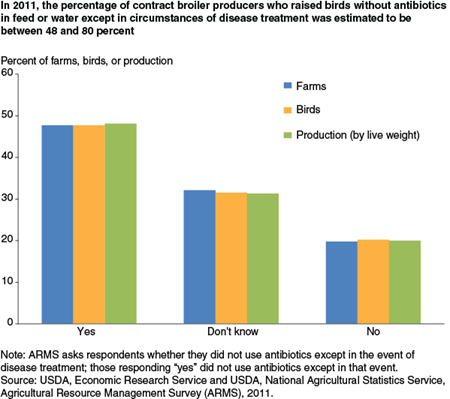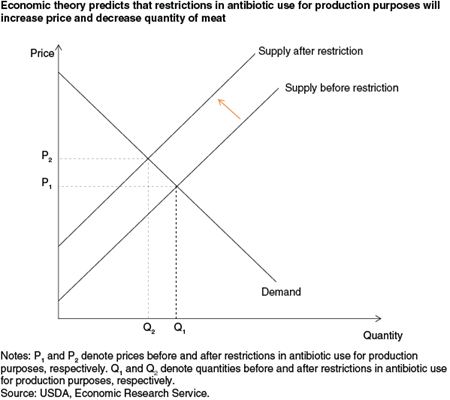Restrictions on Antibiotic Use for Production Purposes in U.S. Livestock Industries Likely To Have Small Effects on Prices and Quantities
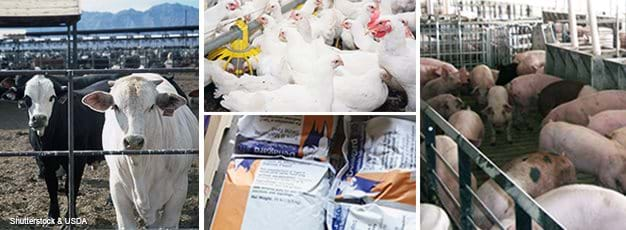
Highlights:
-
Antibiotics are used widely in livestock production for control, prevention, and treatment of disease, and for “production purposes” such as growth promotion. The most recent estimates suggest that approximately 40 percent of finishing hogs and up to about half of broilers received antibiotics for production purposes.
-
Research on the effect of antibiotic use for production purposes shows that such use is associated with a 1- to 3-percent increase in productivity at the farm level. However, this effect is not statistically distinguishable from no effect.
-
A new Federal Government initiative seeks to eliminate the use of antibiotics for production purposes. Model estimates suggest that a 1- to 3-percent shift in supply from policies restricting such uses would lead to approximately a 1-percent increase in wholesale prices and a net decline in production of less than 1 percent.
Farmers use antibiotics to treat, control, and prevent animal diseases and to increase the productivity of animals and operations. Use of antibiotics is common in modern U.S. livestock production, where animals are confined in barns, dry lots, or houses. However, concern is growing that excessive antibiotic use in livestock and humans will contribute to the emergence of organisms that are resistant to most or all antibiotics.
Due to these concerns, pressure is mounting to limit the use of antibiotics in livestock production. In 2006, the European Union (EU) banned the use of antibiotics for growth promotion purposes, and in 2013, the U.S. Food and Drug Administration (FDA) issued final guidance implementing voluntary plans to phase out the use of medically important antibiotics in livestock for production purposes. Consumer interest in products from animals raised without antibiotics is growing, and several major food retailers have placed restrictions on the use of antibiotics for production purposes by their meat suppliers. Changes in antibiotic use will likely lead to a series of adjustments in animal production practices, with potential repercussions for prices and quantities in livestock markets. The extent of repercussions will depend on how widely antibiotics are used for growth promotion and how much such usage affects production and costs at the animal and farm levels.
A recent ERS study uses data from USDA's Agricultural Resource Management Survey (ARMS) to estimate the extent of antibiotic use for various purposes. Using this information together with prior research on the effects of antibiotic use for production purposes on farm-level productivity, ERS researchers estimate that phasing out such uses of antibiotics will result in modest increases in prices and decreases in production in the hog and broiler industries. The limited effects are expected because such use is not universal and because productivity effects at the farm level are small.
How are antibiotics used in livestock production?
Antibiotics are used in livestock production for four main purposes: to treat animals that fall ill (disease treatment); to prevent illness in healthy animals when diseased animals are present (metaphylactic uses or disease control); to prevent disease even when no animals display signs of illness (prophylactic uses); and to promote faster or more efficient livestock growth (production-purpose uses). For production purposes, antibiotics are generally administered via medicated feed and may coincidentally prevent disease.
How could the use of antibiotics in livestock production affect human health?
There are two main concerns about the human health effects of antibiotic use in livestock production. The focus in early regulation of antibiotics in food animals concerned residues in food products. These residues may cause allergic reactions and digestive problems in humans. The FDA has therefore established minimum intervals between the last dosage of antibiotics and the time of slaughter to prevent such residues.
The other main concern with feeding antibiotics to livestock is promotion of the development of drug-resistant bacteria. Studies reported the existence of drug-resistant bacteria in food animals shortly after antibiotics began to be used in production in the 1950s. Drug-resistant bacteria in animals may yield adverse human health effects if people come in contact with drug-resistant bacteria via food, live farm animals, manure, or shed animal material such as feathers, or with infected producers, processing facility workers, or others who live or work on farms. Infected people can then transmit drug-resistant illnesses to others.
The extent to which antibiotic use in livestock production contributes to human health problems is a matter of controversy. The FDA has established that enough scientific evidence exists to support its current actions restricting the use of medically important antibiotics for production purposes. Other scientific and government bodies support the finding of a link between antibiotic use in livestock and human health risks. While such a risk is present, its extent remains in question.
Use of antibiotics for production purposes is not universal in hog and broiler production
ARMS data can be used to assess the percentage of livestock operations administering antibiotics for disease prevention or growth promotion, as well as the percentage of animals receiving such antibiotics in the hog and broiler industries. Due to production contracts common in these industries, farm operators may receive feed from integrators. Vertical integration occurs when large firms or single entities (integrators) control all or several parts of meat production, from feed mills to the retail level. Integrators contract with growers and dictate feed formulations, including administration of growth-promoting antibiotics. Since contract operators may receive feed from integrators, they may not know the content of the feed, including whether antibiotics are present; the survey therefore allows respondents to state that they do not know if antibiotics were administered via feed or water. Because these respondents may actually provide antibiotics, the percentages of operations administering and animals receiving antibiotics are calculated as ranges.
In swine, the uses of antibiotics for disease prevention and growth promotion differ over the lifecycle. Data from the 2009 ARMS show that a sizable percentage of nursery hog operations do not use antibiotics for growth promotion. Among operations with nursery pigs, 62 percent reported using antibiotics for disease prevention purposes, but only 33 percent administered antibiotics via feed or water to nursery pigs for growth promotion. Assuming that all hogs on these operations were administered antibiotics, this represented 23 percent of nursery hogs sold or removed under contract receiving antibiotics for growth promotion and 59 percent receiving them for disease prevention. However, another 8 percent of operators reported that they did not know whether antibiotics were administered via feed or water for growth promotion; this represented a further 26 percent of nursery hogs sold or removed under contract. Overall, the 2009 ARMS data suggest that between 23 and 49 percent of nursery hogs received antibiotics for growth promotion.
While antibiotics for growth promotion have been found to have a larger impact on nursery pigs than on finishing hogs, the data suggest use in the nursery stage may be less prevalent than in the finishing hog stage. Thirty percent of finishing hog producers, accounting for 40 percent of finishing hogs, reported using antibiotics for growth promotion, while another 16 percent of operators (producing 22 percent of hogs) reported that they did not know if antibiotics were administered for growth promotion. Due to the percentages of respondents supplying “don’t know” answers, the percentage of hogs fed antibiotics for growth promotion may have been anywhere from 40 to 62 percent. The percentage of operations administering antibiotics for disease prevention was 44 percent, representing 51 percent of hogs.
In the 2011 ARMS broiler survey, producers were asked whether they raised their broilers without antibiotics in their feed or water unless the birds were sick, which implies not using antibiotics for growth promotion or disease prevention. In 2011, nearly half of operations (48 percent) reported that broilers were only given antibiotics for disease treatment. This response also accounts for 48 percent of birds and 48 percent of production (by live weight). Approximately a third (32 percent) of operators stated that they did not know if they provided antibiotics via feed or water for purposes other than disease treatment; this means the proportion of reporting operations that only supplied antibiotics for disease treatment purposes could be as high as 80 percent. These statistics suggest that in 2011, between 20 and 52 percent of birds were given antibiotics for reasons other than disease treatment.
Because only a portion of hog and broiler producers used antibiotics for production purposes, restricting such uses would have less of an impact on prices or amount produced than if such uses were universal.
How large an effect does the use of antibiotics for production purposes have at the farm level?
Antibiotics used for production purposes may help animals grow faster and gain weight with less food per unit of meat. However, producers may adopt alternative practices that provide similar results. At the farm level, where productivity is measured as the amount of output (meat) per unit of all inputs, alternative practices can include management methods, vaccines, and capital improvements to enhance sanitation. Because farmers make a range of decisions, the effects of antibiotics used for production purposes at the farm level may differ from those at the animal level. Results of statistical analyses accounting for farmers’ complex decision environment find that antibiotic use for production purposes is associated with a 1- to 3-percent increase in productivity of hog and broiler farms. However, these analyses cannot reject the possibility of no effect. Other research finds similar or smaller effects. While the effects on productivity seemed to be higher in the 1970s and 1980s, evidence indicates that productivity effects have declined since then, perhaps due to improvements in breeding, housing, feed formulations, and sanitation practices.
ERS research suggests that broiler producers are more likely to adopt alternative practices to increase productivity when they use antibiotics only for disease treatment. About half of broiler producers who use antibiotics only for disease treatment instead adopt a Hazard Analysis and Critical Control Points (HACCP) plan, and they also adopt sanitation and feeding practices aimed at improving animal hygiene. An HACCP plan is a set of procedures used for preventing, identifying, and controlling food safety hazards.
However, these alternative methods may cost more than using antibiotics for production and disease prevention purposes. Replacing antibiotics for growth promotion or disease prevention purposes may require the use of more labor, capital, or materials on farms, which raises production costs. Research suggests that broiler producers who only use antibiotics for disease treatment purposes have costs that are about 2 percent higher than their counterparts who use antibiotics for production purposes or disease prevention.
Despite the fact that antibiotics used for production purposes appear to have at best a small effect on productivity, they are still widely administered in livestock production. Why? Even with small effects, they may still be profitable choices. Estimated broiler feed costs came to 29 cents per live weight pound produced in 2011. With total live weight production of 9.48 billion pounds, each 1-percent reduction in feed use would be worth $27.5 million to integrators, even if feed prices remained unchanged.
How much impact would reducing antibiotic use for production purposes have on prices and production?
A new guidance from the FDA would eliminate the use of antibiotics for production purposes. Retailers are increasingly offering meat products that have been raised without antibiotics for growth promotion. To assess the effects of reduced antibiotic use on production, prices, and total revenue, ERS researchers used the statistics on frequency of administering antibiotic use for production purposes and estimated effects of such use on farm-level productivity in a model of the markets for chicken and pork. The researchers focused on the effects of eliminating all uses for production purposes; the FDA initiative is more limited, focusing only on antibiotics that are also used in human medicine.
At the market level, if all use of antibiotics for production purposes was eliminated, then livestock would be more expensive to produce and farmers would require higher prices to supply the same quantity. To the extent supplies were affected by higher costs, the shift in the supply would lead to higher prices and a lower level of overall quantities demanded (and hence produced). To estimate various effects at the market level, ERS made assumptions about the range and distribution of several market parameters and then estimated effects under different scenario simulations. This type of analysis enables researchers to assess the range of possible outcomes given multiple uncertain parameters, including the supply-change effect of a ban, the percentage of producers using antibiotics for production purposes before the ban, and how much supply and demand respond to prices. For example, using existing research as a guide, ERS specified that restrictions on use of antibiotics for production purposes would increase the price at every quantity supplied by 1 to 3 percent. For each simulation, a number between 1 and 3 percent is chosen at random and then used to calculate outcomes. ERS conducted 10,000 simulations of the impact of eliminating use of antibiotics for production purposes, using many combinations of supply and demand response, extent of antibiotic use for production purposes, and effect of this use on supply. The means and standard deviations of the outcomes from the simulations are reported in the table below.
| Hogs* | Broilers* | |
|---|---|---|
| Percent change in output | -0.47 | -0.31 |
| Standard deviations in output | (0.18) | (0.14) |
| Percent change in wholesale price | 0.77 | 0.73 |
| Standard deviations in wholesale price | (0.30) | (0.33) |
| Percent change in value of production | 0.29 | 0.42 |
| Standard deviations in value of production | (0.20) | (0.23) |
| *1 to 3 percent reduction in supply from limiting antibiotic use for production purposes. Note: Means of simulations results are reported. Source: USDA, Economic Research Service. |
||
The results of the simulation show reductions in output of less than half of 1 percent for pork and chicken. Wholesale prices increase by 0.77 percent for pork and 0.73 percent for chicken. Prices rise more than output declines, yielding greater total revenue for pork and broiler producers (0.29 percent for pork and 0.42 percent for chicken).
While the change in total industry revenue is positive, the effect on producers depends on whether they used antibiotics for production purposes before the ban. With lower farm productivity, users of antibiotics for production purposes would reduce output by about 1.53 percent for pork and 1.59 percent for broilers, while higher prices would induce nonusers to increase output by 0.48 percent for pork and 0.42 percent for chicken. The simulation estimates average effects at the level of the market, not those for individual producers. Individual producers may see effects of antibiotic restrictions that are smaller or larger than the predicted market changes.
The use of antibiotics for production purposes in livestock agriculture is a contested topic, and recent Federal guidelines have been adopted to reduce the practice. Research indicates that antibiotic use for growth promotion and disease prevention in livestock is not universal and that such uses generally have limited effects on the productivity of raising livestock at the farm level. Given that only a portion of producers use antibiotics for production purposes and that their use appears to have a limited impact, on average, restrictions are predicted to have little effect on prices and quantities produced over time.
Economics of Antibiotic Use in U.S. Livestock Production, by Stacy Sneeringer, James M. MacDonald, Nigel Key, William D. McBride, and Kenneth Mathews, ERS, November 2015


